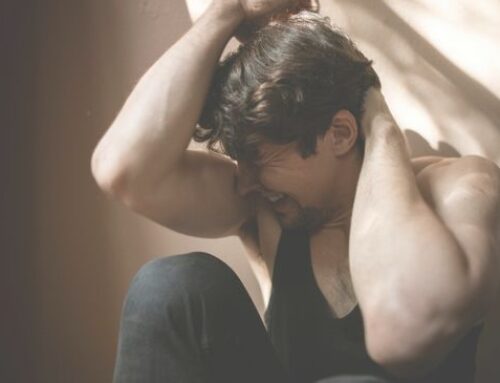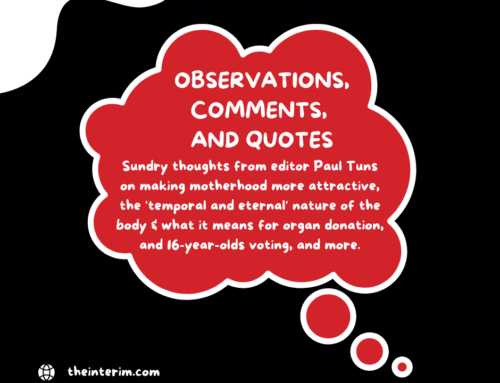You know you are out of place here, in Northrop Frye Hall at Victoria University on May 6, but you have come to ask questions and get information. “Dying with Dignity: a Canadian Society Concerned with the Quality of Dying” (DWD) is holding its annual meeting, and the initial coffee session is a subdued ritual of quiet confidence and renewed acquaintances.
No one is speaking about dying, but it is the bond which has brought them all together. You are given a $40 charitable tax receipt and, after adjusting the cross on your lapel, take a seat in the audience a few rows from the speakers’ table. There are 91 other heads in the room – 41 of them gray.
You notice that the governments of Ontario, Alberta and British Columbia have sent representatives, that a CBC reported is present, and that, incredibly, “100 Huntley Street” has been allowed to videotape the proceedings.
“Last Wish – Voluntary Euthanasia” is today’s theme, and the executive director’s introduction uses familiar phrases. “Freedom of choice” is pivotal to a death with dignity, she says. It is essential that we have “control over death.” She introduces the first speaker as a “compassionate…champion” for this right to choose. He receives a warm round of applause as he walks to the podium. Pieter Admiraal, senior anesthetist at Reinier de Graaf Roman Catholic Hospital in Delft, The Netherlands, has become a “cause célèbre” in the euthanasia movement. In 1973, encouraged by the one-week suspended sentence given to a doctor convicted of killing one of his parents, he began giving lethal doses of drugs to some of his own patients. Aiding him in this were two Roman Catholic priests, with whom he set up criteria to determine eligibility. These were, and still are:
- The patient must be terminally ill.
- He/She must ask for euthanasia spontaneously and repeatedly.
- Mental or physical suffering must be severe and not relievable.
- The patient must know what he is doing and decide freely.
- All other treatment options must be exhausted.
- A second medical opinion must be given.
Informal teams were set up to deal with each patient’s request, each composed of a doctor, a nurse, and a clergyman – often a Roman Catholic priest. (The priest’s function, he explains, was to officiate at “blowing out the candle.”) They discussed all aspects of the case and, if approved, made the necessary arrangements for the death.
At the time determined by the patient, the family and clergyman gathered at the bedside for a farewell service. Then the doctor and nurse entered the room and. After embracing him and giving him a goodbye kiss, administered a lethal dose of barbiturates through an intravenous unit. Unconsciousness resulted within a few hours, death some hours or days later.
Although in many hospitals, as the practice spread, “death from natural causes” was recorded on the coroner’s certificate, Dr. Admiraal has always insisted that his teams prepare checklists of each euthanasia act, signed by the patient before being put into effect. These are then presented to the local officials. He has never been charged with any offence.
Dr. Admiral next discusses his doctor/patient relationship, and here he knows he is on firm ground. A doctor treats persons, not “patients,” and must take time to make friends with them. He should receive training in psychology of dying. He should not abandon them when they need him most. He has seen about 2,000 people die, he says, and has wept for many of them. He uses physical contact – a kiss, a hug – to express his concern, and never allows the family to interfere with this relationship. He knows that most doctors would be ashamed to argue with him in this area.
“When a patient says ‘My life is unbearable,’” he continues, “do not deny it or refer to Christ’s sufferings.”
Dr. Admiral does not distinguish between active and passive euthanasia, and soon you find out why. He equates passive euthanasia with hypocrisy, and says that a caring physician will actively intervene rather than allow a “friend” to die in slow agony.
Touching on Church opposition, he quotes recent opinion polls of uncertain origin which indicate that only 49 per cent of Dutch people believe in God, and that of these only 20 per cent have attended church. The opposition thus has little public support. Since World War II, he adds, religious ministry in The Netherlands has developed a humanistic view.
After fielding several questions from the audience, Dr. Admiraal receives sustained applause before the meeting adjourns for lunch.
As he walks up the aisle, you motion to him. And immediately he comes and sits beside you. You ask him about the Roman Catholic opposition, and he says that, except for Bishop Gyssen (hand-picked by Pope John Paul II) and his followers, the Catholic hierarchy is virtually silent.
“I see,” he says, looking at your lapel, “that you, too, as a Catholic, can support these views. You do support them, don’t you?”
“I don’t support them,” you reply, “because I believe that sometimes suffering is allowed by God for His own purposes.”
He abruptly terminates the conversation, but first tells you that he respects you, and hopes you respect him.
“I won’t lie to you,” you answer.
“Then you will die with all the suffering God will bring to you,” he says, as he walks away.
During lunch you join a sad-looking man and ask him how he got involved. He opens his heart and tells you a long story about his wife’s terminal illness. Unanswered questions are written all over his confused face.
The afternoon session begins with a talk by Robert Risley, the author of the unsuccessful California “Humane and Dignified Death Act.” After stating that “Thou shalt not kill” is the most fundamental law of civilization, he proceeds to analyze his legislative initiative, whose purpose was “to avoid the final agony at life’s end.”
In the precise language of a lawyer, he describes the boundaries controlling this euthanasia request proposal, and concludes that although most lawyers, doctors, and journalists approve of it (and even 61 per cent of Catholics), legislators are not sympathetic. The attack will continue, however, on all levels until right-to-die legislation is enacted.
Mr. Risley is followed by William Harvey, a lawyer, philosopher, and lecturer on medical ethics at the University of Toronto. Mr. Harvey, a member of DWD, also sits on various hospital ethics committees.
He states, referring to Mr. Risley’s proposal, that “California is light years ahead of us,” but goes on to say that Canadian physicians do, in fact, practice euthanasia today. He gives as examples the removal of feeding tubes, the withholding of antibiotics, and the “turning up” of the morphine intravenous rate.
He argues that “good medicine is not helping a person to suffer – for Christ or anything else.” He questions whether someone in a “persistent vegetative state” is really a person.
He ominously refers to a meeting of 75 medical ethics consultants at the Westminster Institute (London, Ontario) recently. One of its recommendations was to include ethics content throughout the medical educational spectrum. You are not sure you want to know what the content will be.
The meeting then subdivides for group discussion. You are pleased that your group contains Robert Risley, the second speaker, and Sydney Rosof, President of the U.S. Right-to-Die Society because you have decided that this is the point at which you “go public.”
You introduce yourself as a committed Roman Catholic trying to determine whether his belief in God as the Supreme Author and arbiter of human life can be reconciled with the views of DWD. Response is formally polite, but because of the shock caused by this admission, you are able to question some of the assumptions being made.
Mr. Rosof is not at all pleased that you are there, but Robert Risley supports some of your opinions.
During the discussion you hear comments such as “meaningless, useless life,” “Biological existence is not life,” and “There are no absolutes here.”
Back in the final plenary session, you ask whether anyone present can reconcile your beliefs with the aims of DWD, Mr. Harvey, the ethicist, answers that not all Catholics hold the same views, and that our task is to care for the patient. He says that some Catholic ethicists have recommended removal of feeding tubes. Three members of the audience (one a Catholic) answer your question as well.
The meeting concludes with a request by the moderator to conduct DWD activities without the “emotional irrationality which, for example, has clouded the abortion debate.” Scores of heads nod their approval.
Strangely, you find yourself invited to a reception that evening, and you accept. Present are the leading members of the two Canadian offices (Toronto and Ottawa), Dr. Admiraal (who stays away from you), Sydney Rosof, and Derek Humphry, founder of the Hemlock Society. Mr. Humphry is the man who in 1975 helped his first wife to commit suicide, then wrote a book about it.
You have long conversations with several of them. Everyone is extremely attentive, and your opinions are treated with the greatest respect.
You speak about the sovereignty of God and peace in suffering, and for the most part your listeners understand what you are saying, but cannot accept it.
In this way you discover a partial answer to your question. No one can tell you whether your Catholic beliefs can be reconciled with the views of DWD, because you do not meet anyone who believes in God.
You conclude that most DWD members are compassionate, well-meaning people, trying to come to grips with the problem of prolonged terminal illness without Faith.
But this doesn’t explain why they have gone out of their way to be nice to you. This bothers you all the way home until, walking across the pebbles and grass in the cool evening air, it comes to you that they may have caught a glimpse, in your quiet enthusiasm and certainty, of something they have never had, or once had and have lost.
If they had it themselves, it would resolve their problem with self-determination, and allay most of their fears about pain in their last illness. It would allow them to die with dignity.
So you resolve to keep them in your prayers, so that, in the words of the Good Friday liturgy, “in spite of the hurtful things that stand in their way, they may recognize in the lives of Christians the tokens of your love and mercy, and gladly acknowledge You as the one true God and father of us all. Through Christ our Lord. Amen.”
The author lives in Toronto and will contribute stories on euthanasia to future issues of The Interim.




